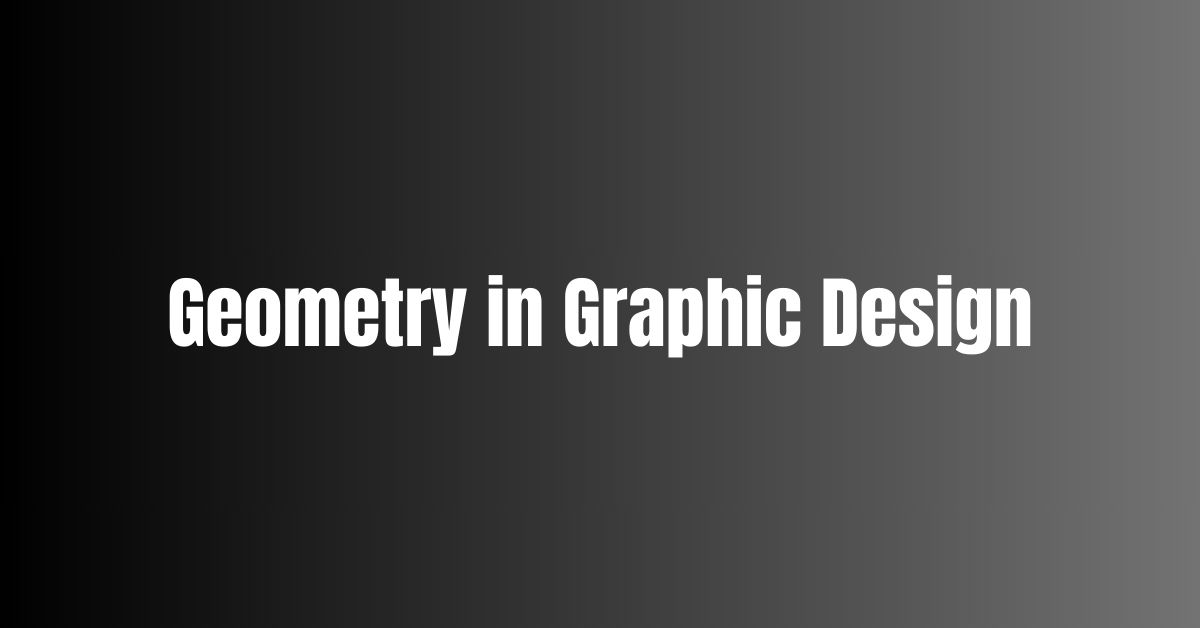Graphic design is a versatile art form encompassing various techniques. A crucial aspect is geometry, which provides structure, brings harmony, and ensures balance in design. This article aims to explore how geometry influences different levels of graphic design, including its use in creating logos, typography, and even web design. We'll also discuss how these geometric applications could potentially affect composition, color schemes, and both digital and print layouts.
Introduction to Geometry in Graphic Design
Geometry, a branch of mathematics dedicated to shapes, sizes, properties, and dimensions, plays a crucial role in graphic design — a visual communication art form that hinges on creating visually harmonious designs. With its roots embedded deeply in mathematics, geometry substantially contributes to creating balance and harmony in graphic design. It's intriguing to observe how seemingly simple geometric shapes can form the basis of compelling and aesthetically appealing designs, like constructing eye-catching logos. Therefore, the purpose of our discussion today is to delve into the far-reaching influence of geometry at varying layers of graphic design. One finds, in this context, that geometry's impact on design goes far beyond mere aesthetics. So, let's transition smoothly into our exploration of how geometry molds the world of graphic design.
The Building Blocks: Basic Shapes
Let's dive into the basics of graphic design starting with the fundamental geometric shapes: circles, squares, triangles, and rectangles. Just to clarify, when we refer to a circle, we mean a shape that is perfectly round. A square is an object with four equal sides and four right angles. A triangle is a shape created by connecting three points, and a rectangle is a four-sided object with opposite sides equal and angles of 90 degrees. These are all clean, simple shapes, but they serve as the foundation for every elegant and intricate design you see around you.
Take, for instance, the famous Nike logo. At its very core, this iconic design uses a simple curve, almost a quarter of a circle. Or consider the Windows logo, which is essentially formed from four squares. These examples show us the power and versatility of basic shapes in graphic design.
Not only do these shapes provide the basic structure for designs, they're vital for ensuring balance within a composition. Think about what happens when a design lacks balance. It becomes chaotic, confusing, and difficult to comprehend for the viewer. On the other hand, using geometric shapes meticulously can deliver clean, ordered designs which hold the viewer's attention.
As we continue in this article, I invite you to keep these thoughts in mind. Consider how the humble circle, square, triangle, and rectangle become the building blocks of the designs we encounter every day. It's a striking reminder of the harmony and balance that's possible when we master the basics.
Symmetry and Balance
Symmetry, a key concept in geometry, is essential in graphic design. In graphic design terminology, symmetry refers to the balanced placement of design elements in a composition. Think of it as creating a mirror image - when a design is divided down the middle, the elements on one side mimic the elements on the other. This approach is often used in designing logos, laying out websites, or creating posters. This balanced distribution of design elements results in visually pleasing aesthetics. The symmetry guides a viewer's eye, creating a sense of harmony and unity across the design. So, in the realm of logos, website layouts, or posters, symmetry is the secret behind their eye-catching appeal.
Golden Ratio
The golden ratio, commonly known as φ (phi), is a principle that helps strike a visually pleasing balance in designs. Simply said, it's a mathematical ratio that graphic designers employ to decide the best size and position for different elements in a design. For example, the golden ratio can influence the layout selection, font sizes, and logo arrangement in graphic designs. Graphic designers find it remarkably useful to create designs that engage and attract viewers. It is worth reiterating just how significant the golden ratio is in crafting visually appealing designs. Interested in exploring more about the golden ratio? Click here.
The Role of Geometry in Logo Design
Logos occupy a significant spot in graphic design, serving as the visible face of any brand or business. These images carry weight: they must encapsulate the brand's core identity and be easy to remember. A key player in crafting such compelling logos is geometry. Geometry, in crafting recognizable shapes and structures, adds a distinct flavor to a logo, making it stand out. Take, for instance, the famed Apple and Mercedes-Benz logos. Geometry's role in their creation is clear and considerable. In the next sections, we will examine how several iconic logos have harnessed the power of geometry for effective visual communication.
Creating Iconic Logos
The design of many famous logos, such as Apple's, cleverly employs geometric shapes. The Apple logo, contrary to what you might think, isn't just an apple shape - it's a subtly modified circle that's been asymmetrically bitten. Principles like the golden ratio or symmetry are central to the design process, making these logos not merely simple, but strategically powerful. The use of geometry aids in engraving a visual memory, contributing significantly to brand recall. For a deeper insight into the role of geometry in logo design, stay tuned for the next section.
Typography and Geometry
Typography, the art of arranging type, plays an essential role within the realm of graphic design. It employs the use of geometric shapes to create brand-specific fonts and unique text designs. As an example, consider how the universally recognized 'Helvetica' relies on geometric principles for character formation.
Geometry heavily influences the alignment of text and the space between each character. It could be as simple as the consistent line height in a paragraph to the equal spaces between letters in a word. This leads to a balanced and visually intriguing design where both aesthetics and functionality of design come together harmoniously.
Thus, the application of geometric principles in typography contributes greatly to creative and effective brand messaging in graphic design. It's clear that geometry in typography is instrumental to crafting aesthetically pleasing and functionally effective visual designs.
Geometry in Web Design
Understanding the crucial role of web design in today's digital era involves recognizing the part of geometry. Geometry provides a blueprint for systematic content arrangement, aiding easy navigation and creating visually pleasing, grid-based designs. It also utilizes basic geometric shapes; circles for buttons or prompts, squares and rectangles for text or image frames, and triangles to signify direction or priority. Balancing these elements through a symmetrical layout using geometric shapes contributes to a visually attractive and user-friendly design. The sequence of content, designed adhering to the golden ratio principle, has proven to enhance visual appeal and user experience significantly. Moreover, responsive design, a critical aspect of modern web design, also involves a certain level of geometry, showcasing its growing importance. Thus, by understanding the connection between web design and geometry, one can create a more balanced, visually appealing, and easy-to-navigate website.
Grid Systems
Recognizing the importance of an organized and user-friendly website design, geometric grid systems play a crucial role. By using geometric principles like symmetry and balance, a structured layout is created. This layout, with its evenly spaced elements, strategic alignment of content, and consistent scale, makes it easy for users to navigate through the website. What's more, these geometric practices offer a unified visual presentation, harmonizing the various elements on the webpage. Plus, these grid systems are designed to adapt across different screen sizes, ensuring that the website's design stays consistent across devices. In summary, the importance of geometric principles in grid systems for web design cannot be overstated, providing navigability, visual harmony, and a responsive design.
Responsive Design
Responsive website design significantly relies on geometry. Geometry aids in shaping a site's responsiveness, adjusting the layout, images, and text size to fit various screen sizes. Just consider major websites like Amazon or Google; they use geometric principles to ensure their sites look good and function properly regardless of whether you're viewing them on a laptop or a smartphone. This adoption of mathematical concepts keeps websites user-friendly across a range of devices. In essence, without geometry, a website's responsiveness would be compromised, underlining the crucial role geometry plays in web design. Therefore, careful attention to geometry is key in achieving a successful, responsive web design. Reading through this paragraph again affirms how logically the information progresses and how each sentence actively asserts the importance of geometry in responsive web design.
Beyond the Screen: Print Design
Far from being confined to the digital realm, geometric principles play a pivotal role in print design. This extends to brochures, posters, and business cards. The use of geometry, for instance, helps achieve balance and symmetry, bringing a visually appealing and comprehensible layout. Examples abound where geometry has been utilized effectively in print design. Its application enhances the visual appeal, bolsters communication effectiveness, and increases user engagement. Adopting geometric principles in print materials isn't merely an option—it's an integral part of the design process.
Layout and Composition
In the digital age, a key rule of thumb in print design is to follow certain patterns based on shapes and lines, known as geometric guidelines. For example, grid systems, symmetrical balance, and proportions are often used to lay out elements on a page. This can become evident when browsing through a well-designed magazine or brochure. Such a rule-based approach makes content more pleasing to the eye and easier to comprehend.
Following geometry not only aids in readability but also contributes to overall aesthetics. For instance, a layout following the 'rule of thirds' can be visually dynamic and interesting, yet easy to navigate. Hence, utilizing such shape-based rules indeed holds significant value in design.
Even the choice of colors...
Geometry in Print Design Layouts
To understand these principles further, think of compositions where distinct geometric shapes are employed. Picture a textbook page, where boxes, lines, and circles are used to highlight important points - making them effortlessly digestible. By breaking down complex information into easy chunks, these patterns enhance readability.
Thus, just like color choices or typography, geometric guidelines form an integral part of website and print design. While it may sound complex, it's essentially about aligning elements using various forms and lines. Let's further unfold how this works in the next section.
Color Schemes and Geometry
Furthermore, geometry has a significant impact on the choice of colors. For instance, the selection of complementary colors can hinge on the wheel's geometric relationships. Complementary colors, which are opposite on the color wheel—a typical geometric shape, would be a good example.
A case in point is the well-known Google logo, which cleverly employs complementary colors based on geometric relationships in the color wheel. This allows a better visualization of the concept. Striking a balance in the use of colors, not just in print design but also in digital media, reinforces the connection between geometry and design.
Conclusion
Geometry isn't just a math concept; it's a crucial tool for graphic designers. It helps create balanced, visually appealing designs. Let's get specific: in logo design, geometric shapes fashion a memorable, balanced image. Web design uses geometry for a clean, user-friendly interface, and print design uses it to boost readability and aesthetic.
Through each example, it's clear: geometry is key in achieving balance, harmony, and visual appeal in design work. But remember, each design field applies geometry uniquely, shaping distinctive outcomes. By avoiding repetitive details, it keeps each paragraph providing fresh, relevant information.
Frequently Asked Questions
- How does symmetry enhance the visual appeal of a graphic design? Symmetry ensures that elements are evenly distributed, creating a sense of balance and aesthetics in the design.
- What are some famous logos that use geometry effectively? Famous logos like Nike’s swoosh and the Mercedes-Benz emblem are excellent examples of geometric logo design.
- How can I apply the golden ratio in my graphic designs? You can use tools or templates that incorporate the golden ratio, or manually calculate it to create visually pleasing proportions in your designs.
- Why is responsive design important in web design, and how does geometry play a role? Responsive design ensures that websites look and function well on different devices. Geometry helps in creating adaptable layouts and content placement.
- Are there any tools or software that can assist in applying geometric principles in graphic design? Yes, there are various graphic design software, such as Adobe Illustrator and Canva, that offer tools for working with geometric shapes and proportions.




